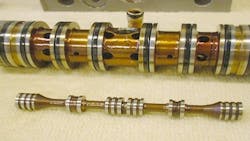Varnish in hydraulic systems starts off as soft, insoluble contaminants that are so small they pass right through filters and go undetected by particle counters. They collect throughout a hydraulic system and can eventually become varnish that causes valve sticking and other system malfunctions.
These insoluble soft contaminants caused by a combination of water, heat, and oxygen. The heat is caused by static discharge, a process discovered several years ago that damages a filter's center core. Now, with additional study, there is solid visual proof that static discharge occurs throughout the entire hydraulic system, causing the formation of tar and varnish and reduced system performance.
Read the whole story by clicking here.
About the Author
Alan Hitchcox Blog
Editor in Chief
Alan joined Hydraulics & Pneumatics in 1987 with experience as a technical magazine editor and in industrial sales. He graduated with a BS in engineering technology from Franklin University and has also worked as a mechanic and service coordinator. He has taken technical courses in fluid power and electronic and digital control at the Milwaukee School of Engineering and the University of Wisconsin and has served on numerous industry committees.

Leaders relevant to this article:
